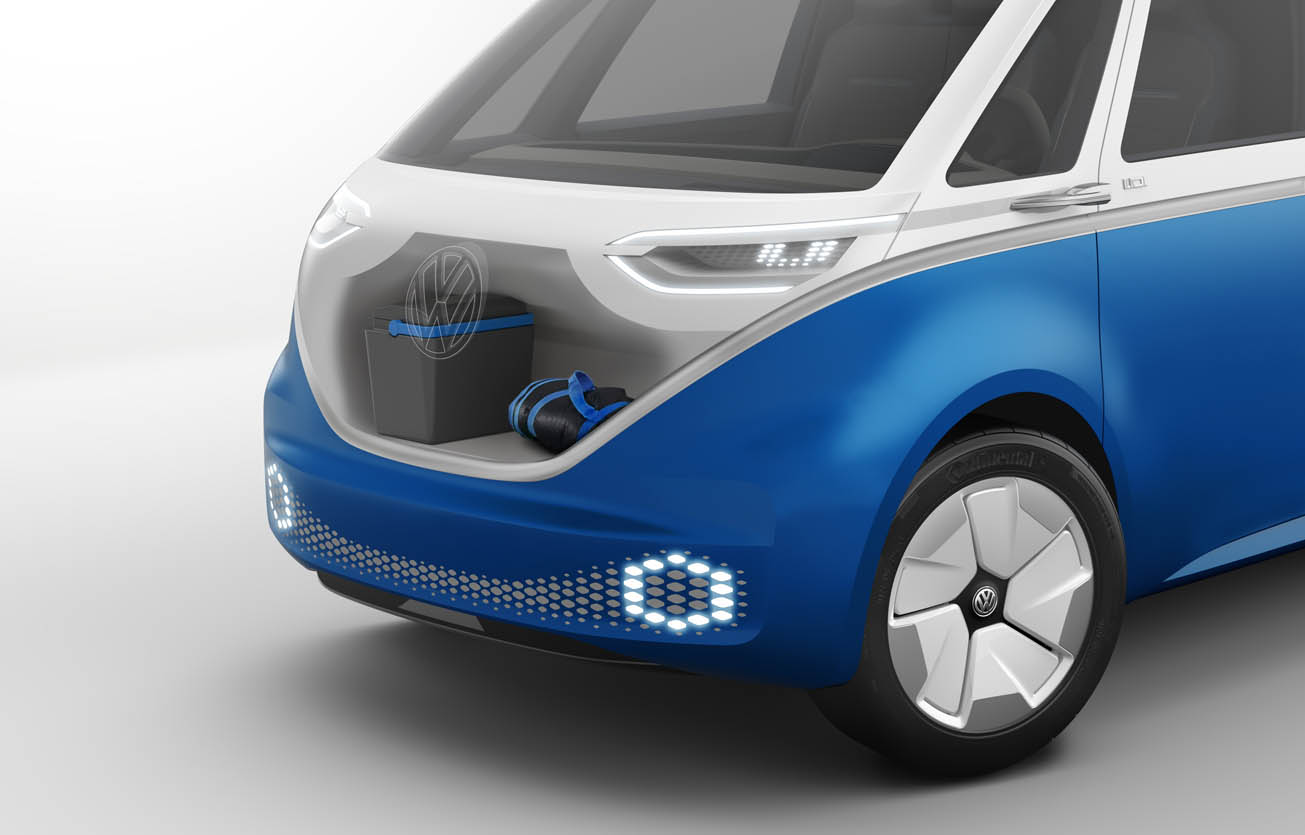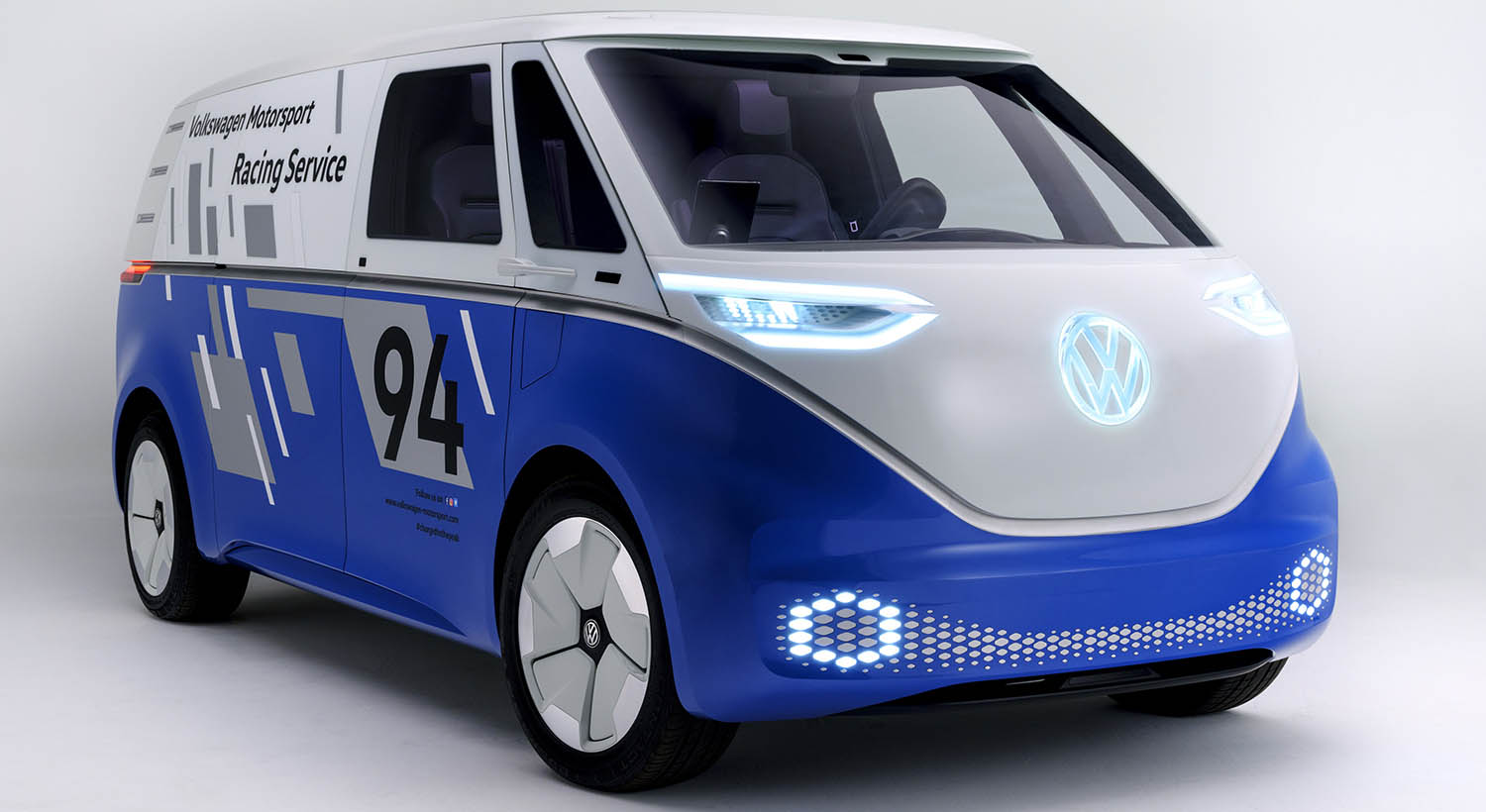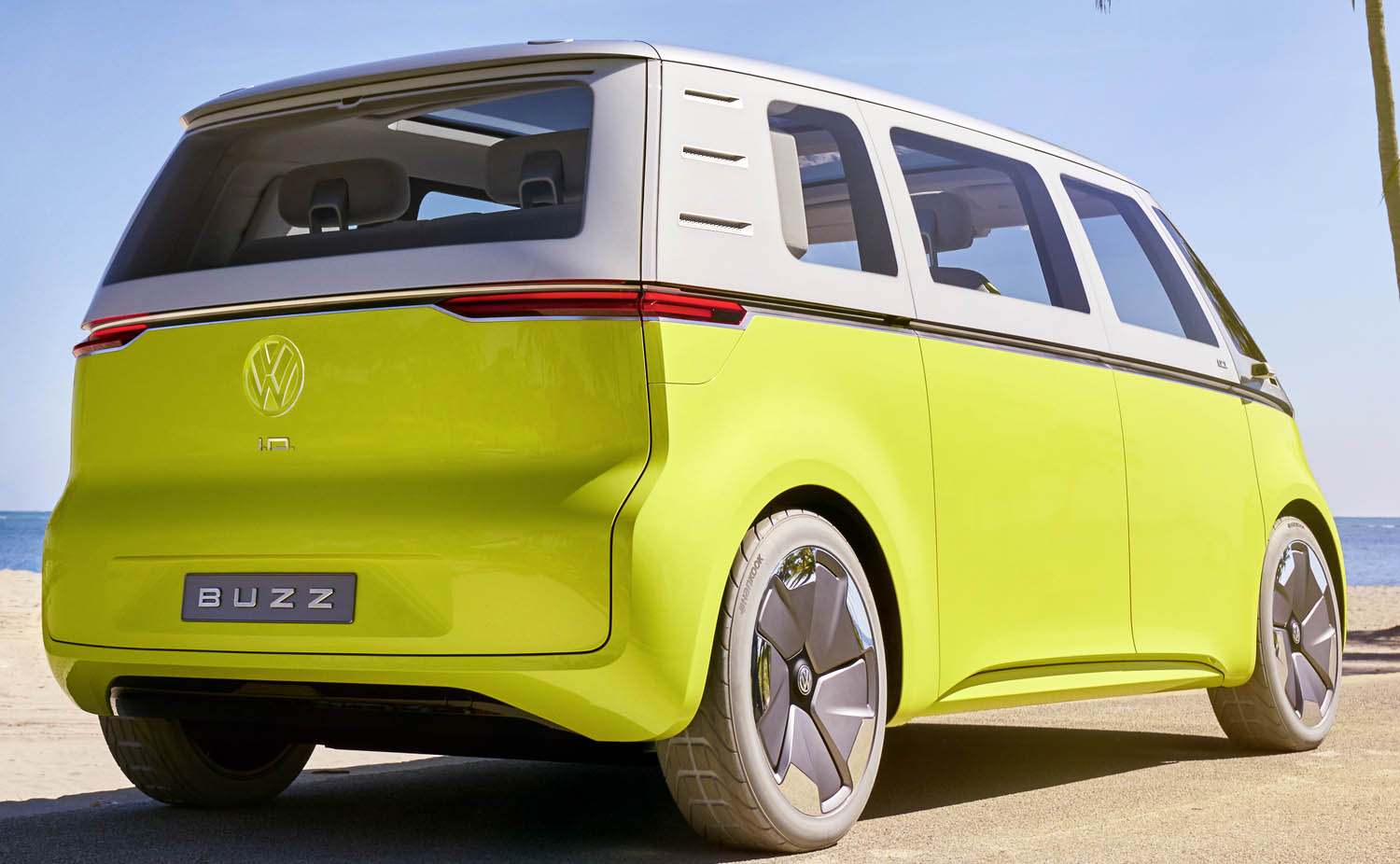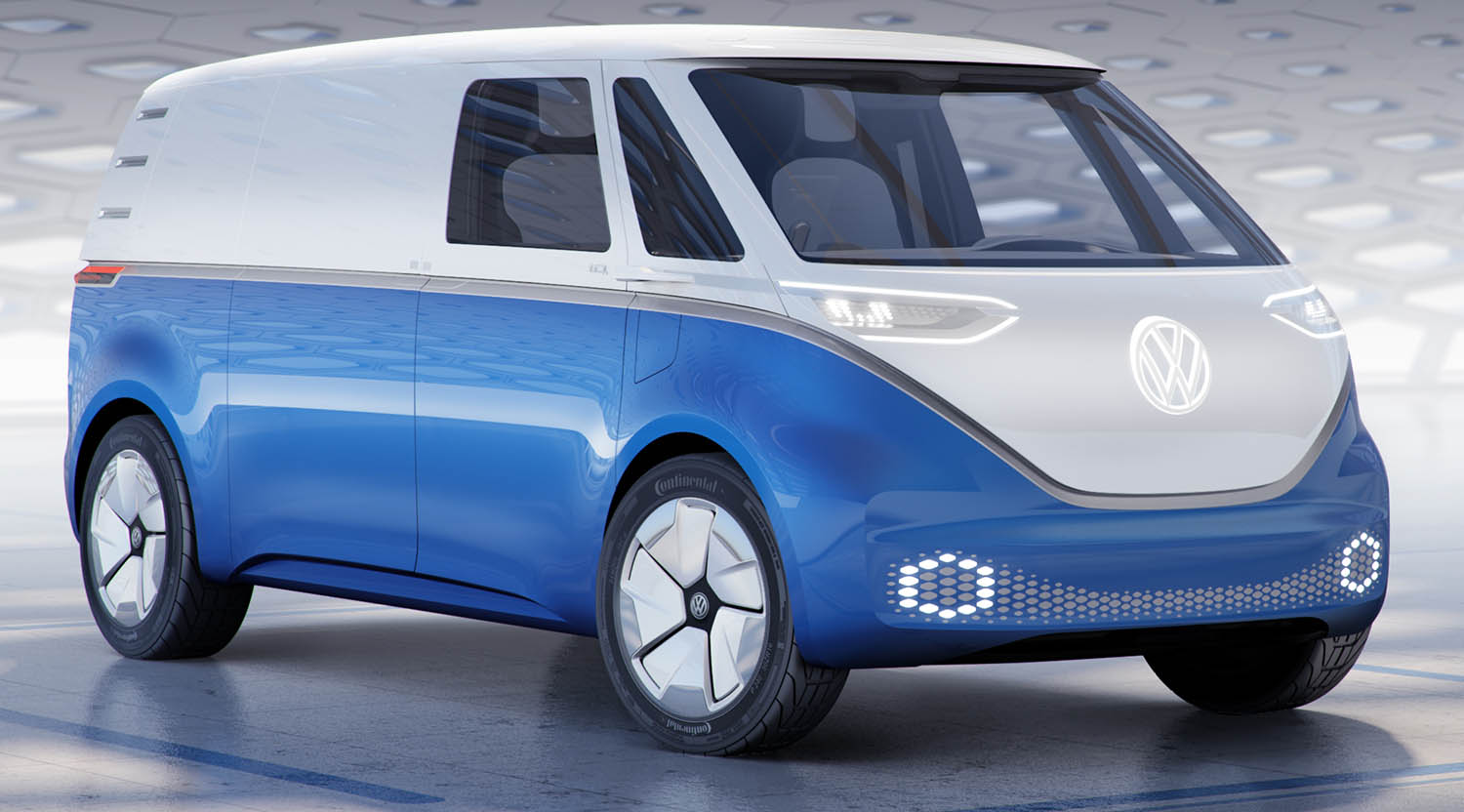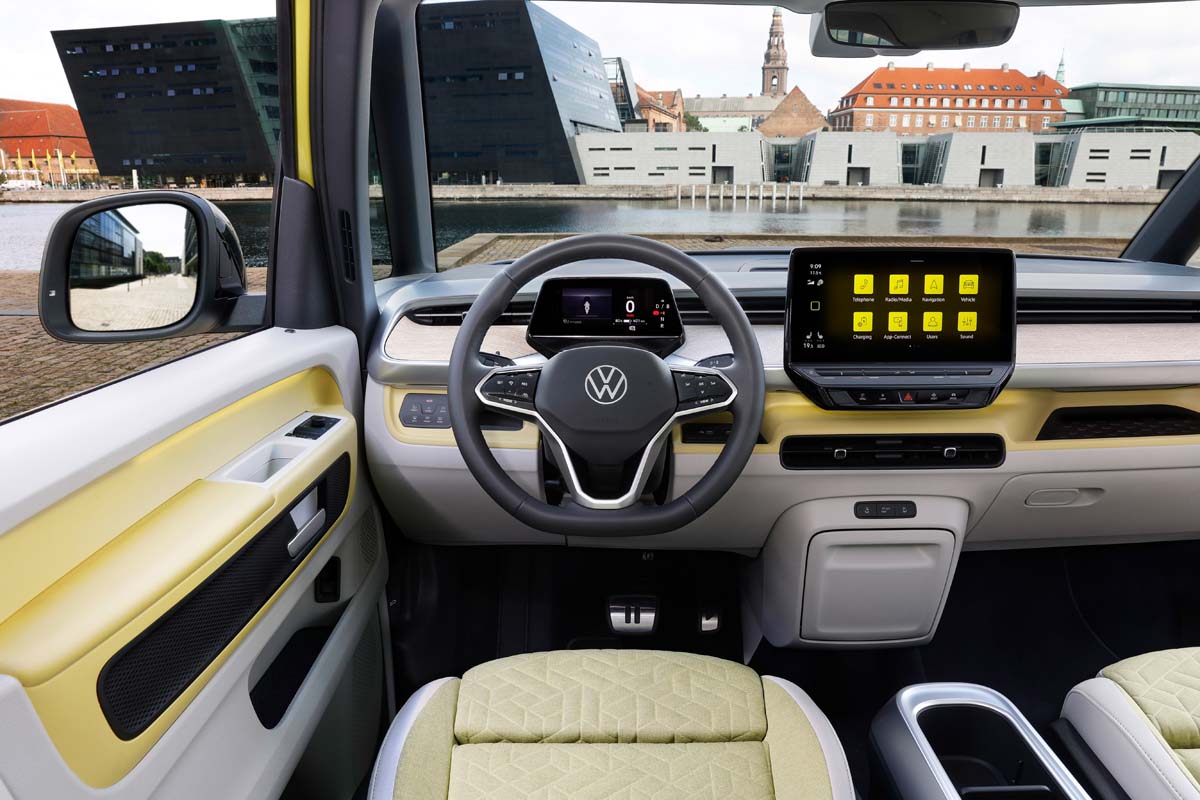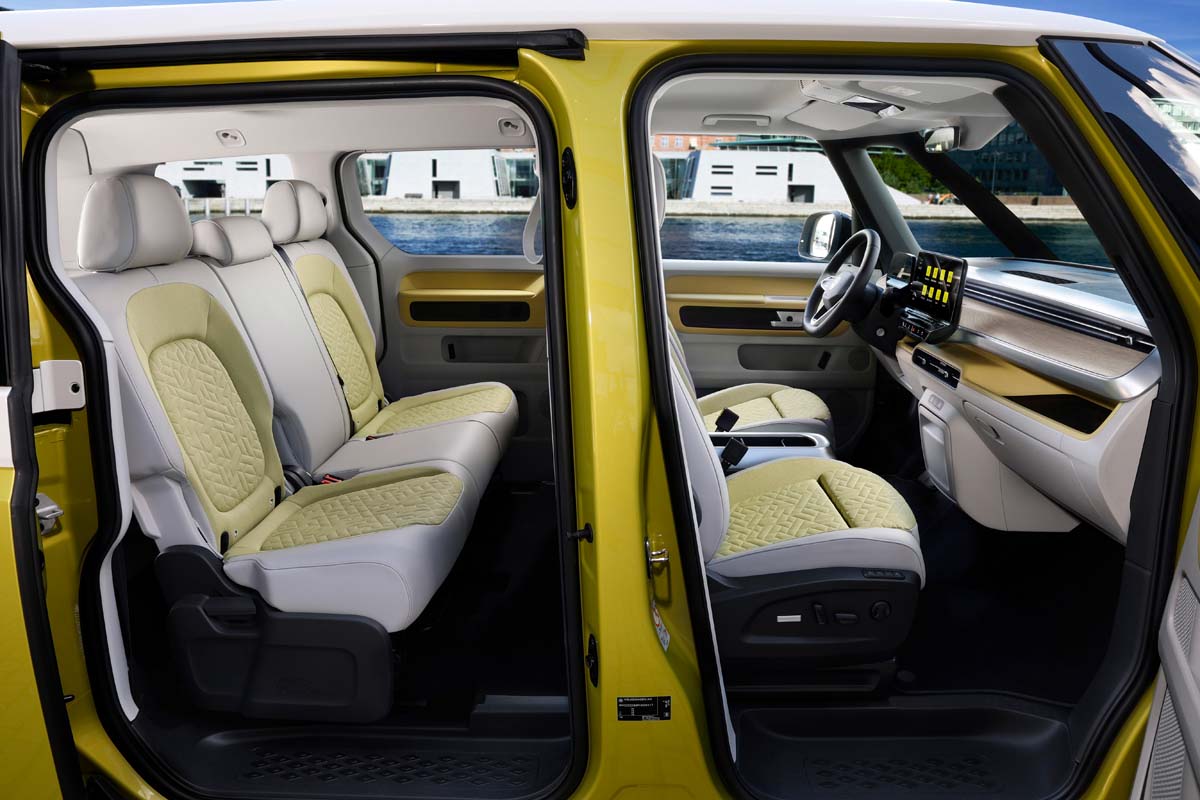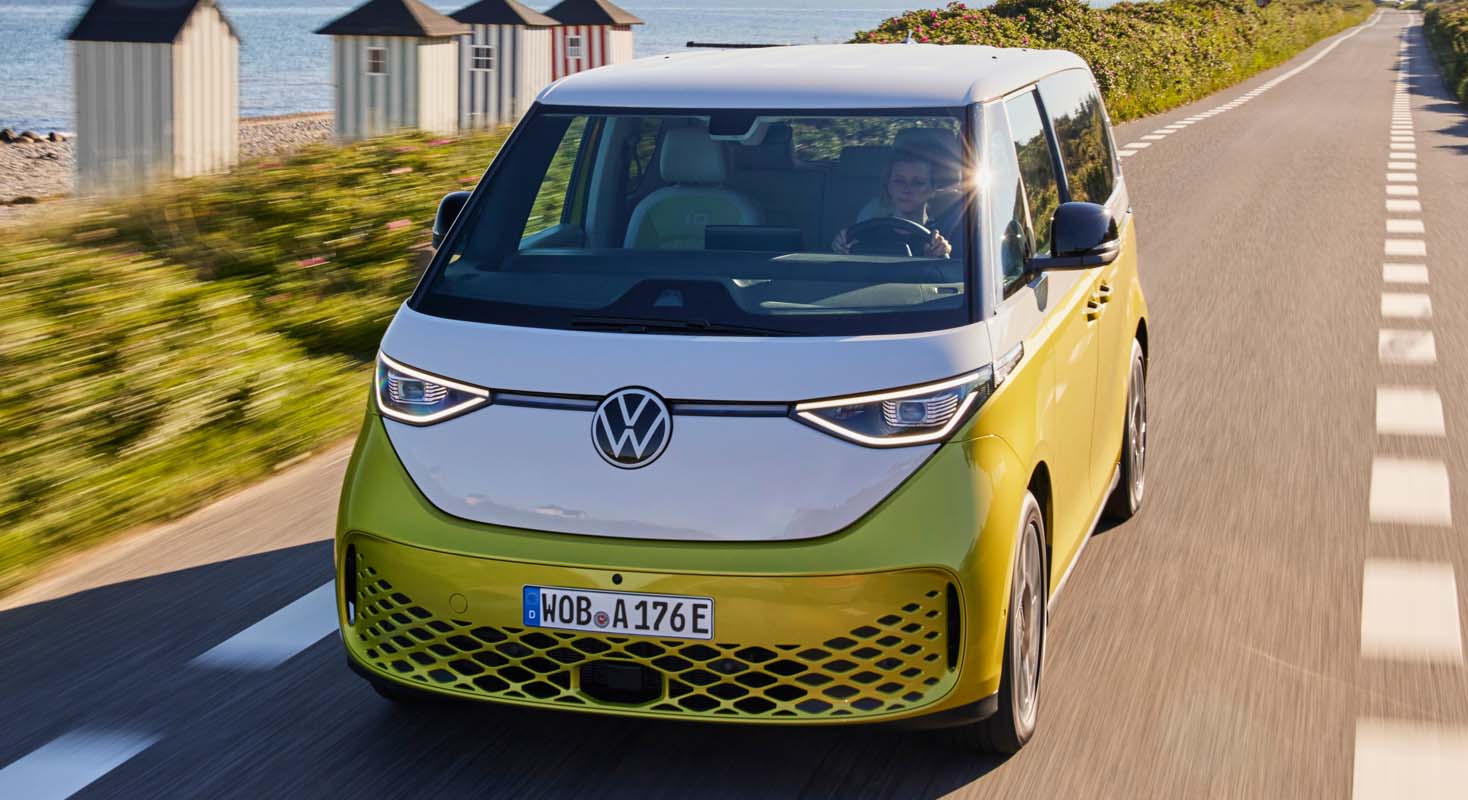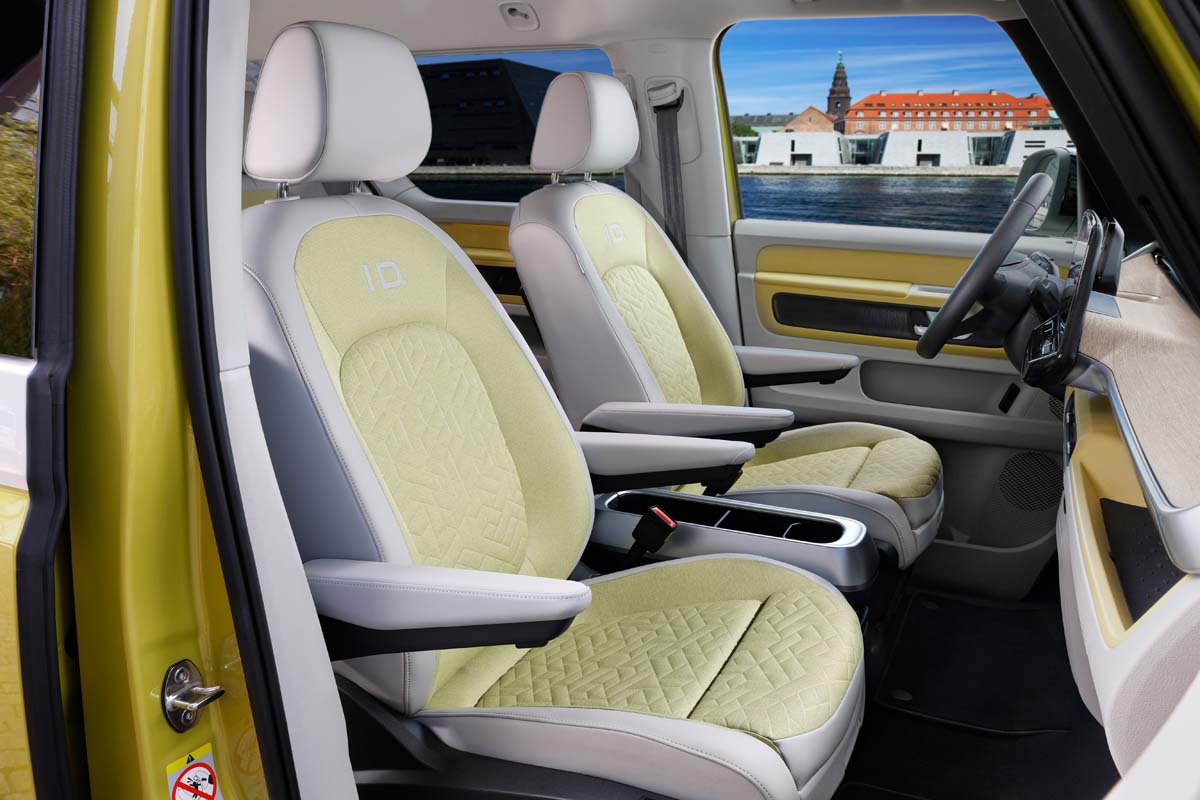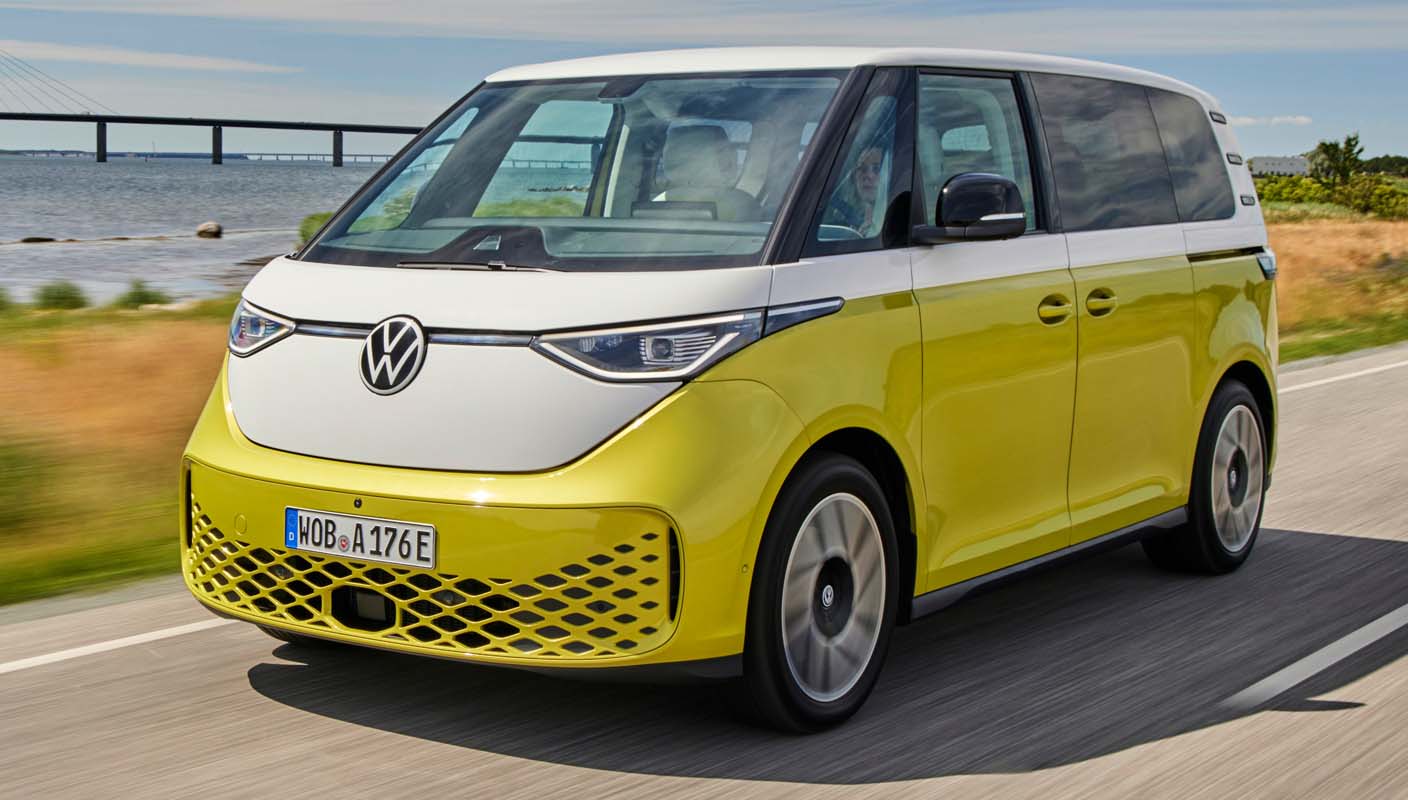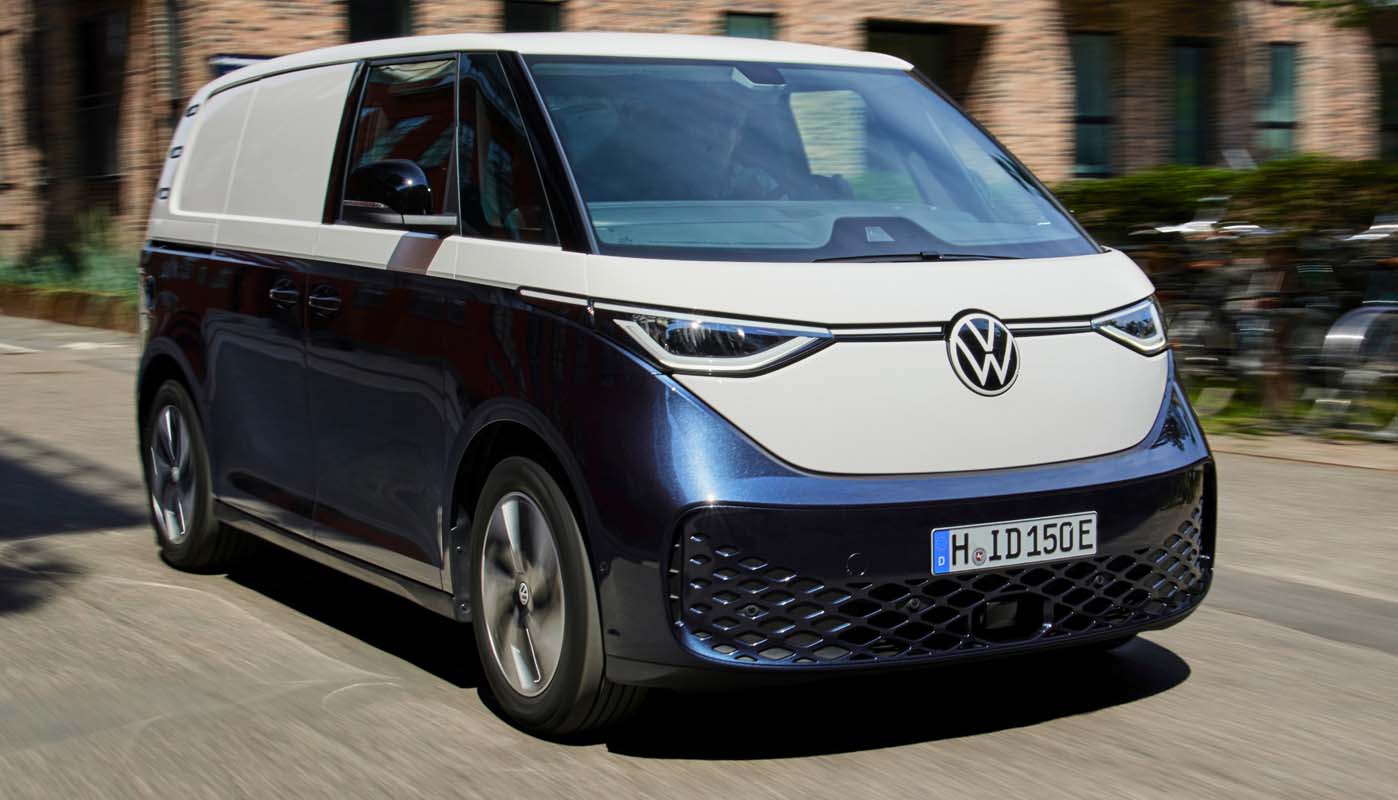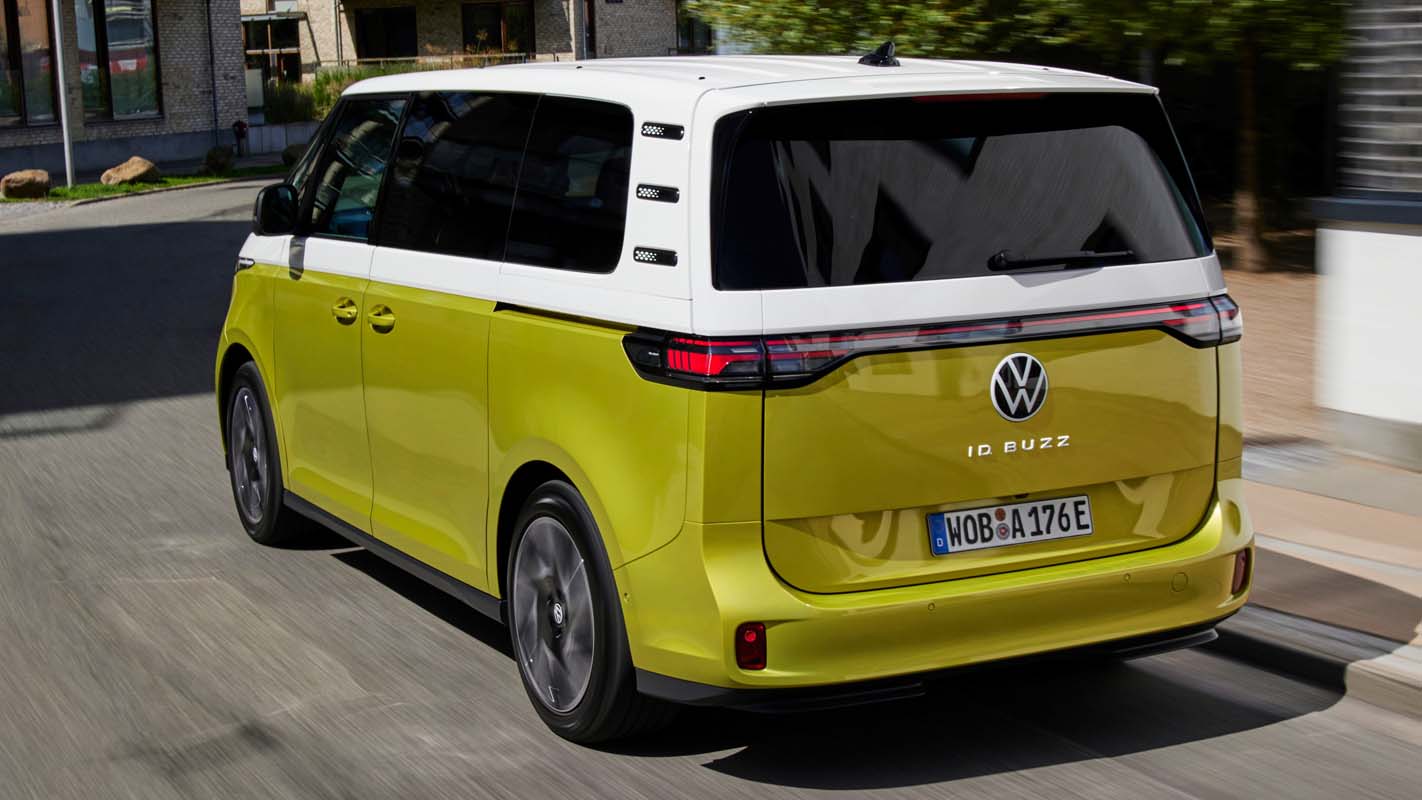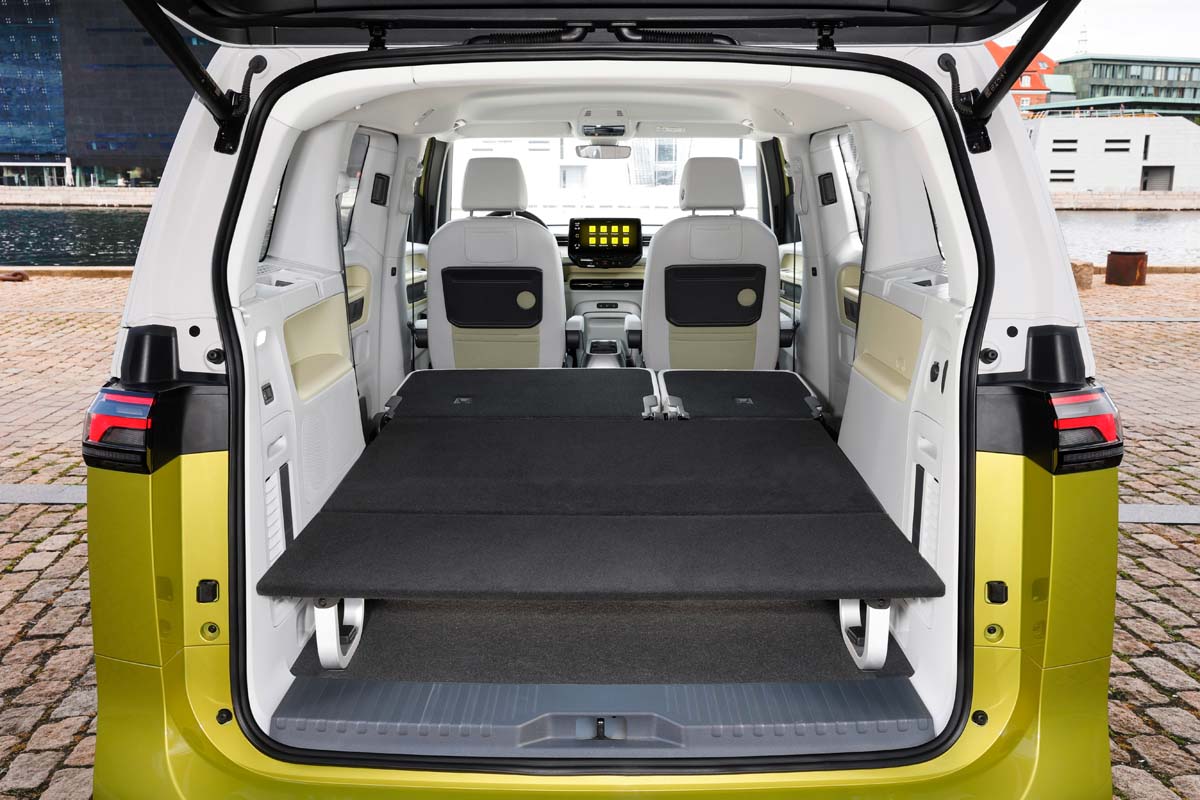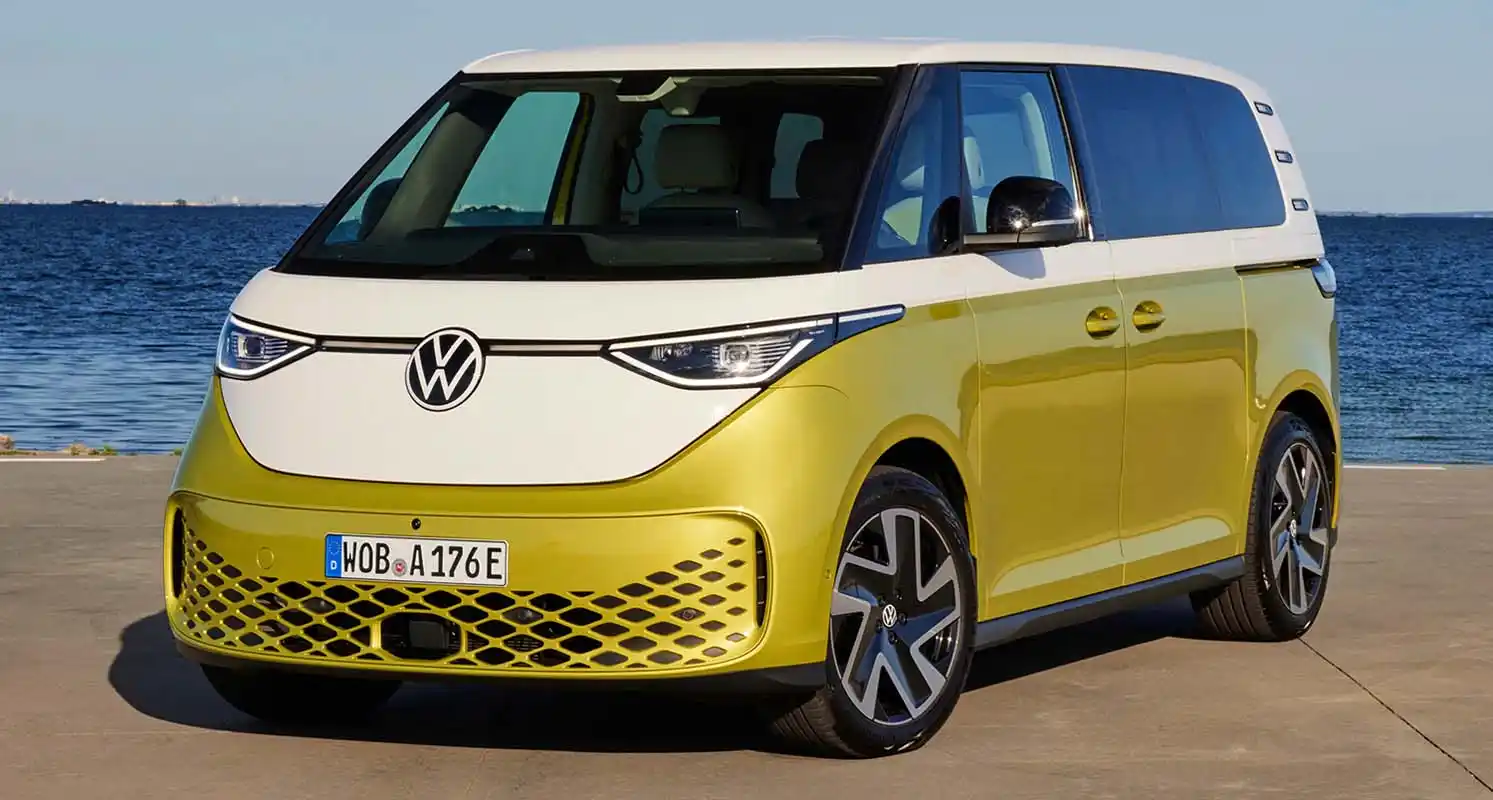
The ID. Buzz reflects a new era for motoring. Volkswagen Commercial Vehicles has already begun sales in Europe and the first vehicles will be delivered to their owners this Fall. There are two versions: the ID. Buzz2 MPV and the ID Buzz Cargo1 van. The ID. Buzz is an avant-garde vehicle for families, active people and businesses.
The style is clear: iconic, powerful and friendly. The tight overhangs of the aerodynamic body (cd 0.29) correspond visually with the agile drive characteristics. The 150 kW (201 horsepower) electric motor makes its maximum torque of 310 Nm (229 lb-ft) immediately available. Thanks to the rear-wheel drivetrain (as in the original T1 Bus), the steering is also free of any influence from the drive system. The 77-kWh (net) battery is integrated deep within the vehicle floor to help to lower the center of gravity and reduces roll to a minimum. The weight is spread centrally within the vehicle, thus ensuring neutral handling. All of this, as well as a tight turning circle of just 11.1 meters (36.4 ft), makes the ID. Buzz the ideal vehicle for city driving as well.
In the combined WLTP cycle, the range of the ID. Buzz is up to 263 miles; the ID. Buzz Cargo goes up to 264 miles. The battery can be charged at home, at work or at public AC charging points using an 11 kW on-board charger. At DC fast-charging stations, ID. Buzz can pull as much as 170 kW, allowing for 5 to 80 percent charging in just 30 minutes. The vehicles can also charge via ‘Plug & Charge’; which allows for automatic activation and billing.
New driver assist systems, such as Travel Assist with swarm data utilization and assisted lane-changing, are available. Park Assist Plus with memory function for automatic maneuvering into the garage at home, a carport or a space in the company car park is also new. In Europe, many driver assist systems are included as standard, such as Car2X (warns of hazards in the near vicinity) and Front Assist with pedestrian and cyclist monitoring (Autonomous Emergency Braking). The ID. Buzz vehicles leave the factory with the latest Volkswagen ID. Software version 3.2 that can be simply updated over the air.
Conceptually the ID. Buzz adds another element to electric motoring. Carsten Intra, CEO of the Board of Management of the Volkswagen Commercial Vehicles Brand says: “No other vehicle manufacturer has a comparable all-electric MPV and van duo in their portfolio. The avant-garde technology and design concept of the ID. Buzz and ID. Buzz Cargo are globally unique.”
“The ID. Buzz appeals to all sorts of different customers—families, people who need lots of space for their hobby, plus business owners and the manual trades,” says Thomas Schäfer, Volkswagen AG Management Board Member and Head of the High-Volume Brand Group. “People opting for the ID. Buzz will be just as likely coming across from an SUV or the van world as Bus fans who want to go electric. This model is therefore of exceptional importance for Volkswagen and Volkswagen Commercial Vehicles.”
At 185.5 in, the two ID. Buzz models are the same length. The wheelbase is long, too, at 177.7 in. Optimum use is made of the space between the axles. Depending on specification, the ID. Buzz and ID. Buzz Cargo are between 75.9 to 76.8 inches high. Excluding wing mirrors, both models are 78.1 in wide. At 24.9 in high, the load sill of the ID. Buzz and ID. Buzz Cargo is nice and low.
As an MPV, the spacious ID. Buzz is just as ideally tailored to leisure time as it is to business use. Driver and front-seat passenger sit on individual seats equipped with standard adjustable inside armrests. In the back, the three-seater bench is split 40:60 and its backrests can be folded down. To create extra legroom or additional luggage space, it is also possible to move the two parts of the bench seat lengthways by 5.9 inches. The MPV’s two sliding doors come as standard. With five people on board, there is 39.6 cubic feet of luggage space behind the second row that expands to 77.9 cu ft when the second row is folded.
The ID. Buzz Cargo is one of the most modern vans anywhere in the world. It is being offered as standard with three seats in the cab: driver’s seat plus double bench. If desired, a single seat for the front-seat passenger is also available. Behind the seats comes a fixed partition, separating off the cargo space. This partition is optionally available with a window and/or an opening through which items can be loaded. The cargo space capacity is 137.7 cu ft and provides room for two Euro pallets. The ID. Buzz Cargo is fitted with a wide-opening rear hatch and a sliding door on the passenger side. The van is optionally available with an additional sliding door on the driver’s side and with rear double doors.
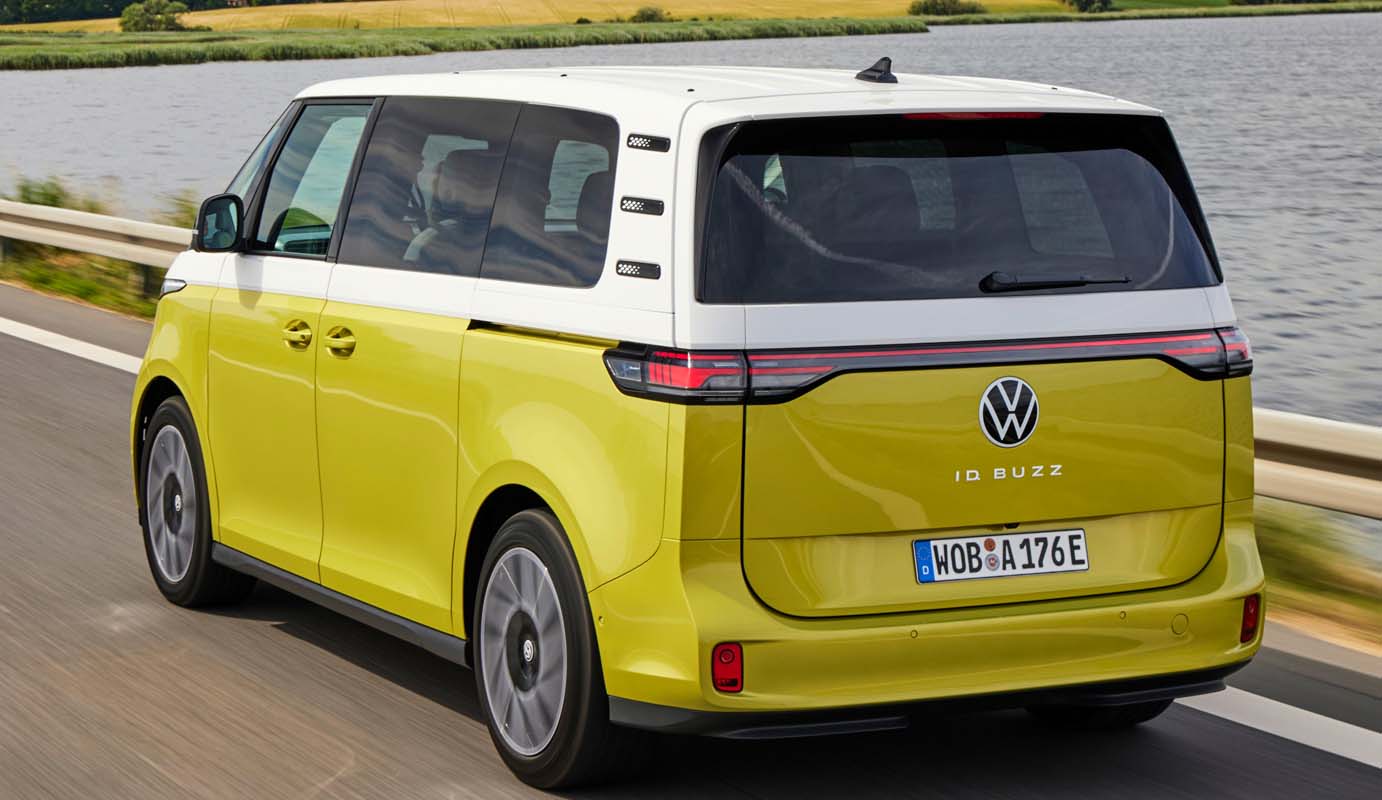
The new ID. Buzz and ID. Buzz Cargo are being produced, along with the new T7 Multivan, in the Hannover plant in Germany, the headquarters of Volkswagen Commercial Vehicles.
AGILE, POWERFUL AND EFFICIENT ELECTRIC DRIVE SYSTEM
The ID. Buzz and ID. Buzz Cargo are based on the Volkswagen Group’s Modular Electric Drive Matrix (MEB). In the ID. Buzz, the MEB system is made up of the permanent-magnet synchronous motor (PSM for short), a power electronics unit, an automatic single-speed gearbox, the 12 lithium-ion battery modules and various additional components integrated within the vehicle’s front end. The battery has a net energy capacity of 77 kWh (82 kWh gross). The flow of high-voltage energy between the motor and the battery is managed by the power electronics unit, converting the direct current (DC) stored in the battery into alternating current (AC). The on-board electronics are in parallel supplied with 12V power via a so-called DC/DC converter.
The electric motor is integrated into the driven rear axle and develops a power output of 150 kW (201 hp). The instant 229 lb-ft of torque ensures very good acceleration, with a 0-62mph time of 10.2 seconds. The top speed is electronically limited to 90 mph. The ID. Buzz is classified in the top efficiency class in Germany: A+++.
The lithium-ion high-voltage battery is charged via a connection point on the rear nearside of the vehicle. On a Level 2 charger, the battery can go from 0 to 100 percent at a charging rate of 11 kW in 7 hours 30 minutes. On the road, the ID. Buzz can be charged at DC fast-charging stations at up to 170 kW. In this case, the battery is charged up from 5 to 80 percent in around 30 minutes.
THE LATEST SOFTWARE
The ID. Buzz Pro and ID. Buzz Cargo leave the production plant in Hannover with the latest Volkswagen ID. 3.2software. It facilitates, among other things, the ‘Plug & Charge’ function at compatible DC fast-charging stations. Furthermore, planning long journeys is particularly easy with ID. Software 3.2, as the vehicle’s navigation system intelligently and automatically integrates the charging stops into the route planning (e-route planner). In the latest version the routing algorithm for this has been enhanced.
The system also offers refined settings options for personal preferences: these include, for instance, a charging time optimization function in order, where desired, not to charge for an unnecessarily long time at the last charging stop before a destination. It will also be possible to use the Apple Music and Spotify streaming services via the infotainment system, whether the smartphone is connected or not. With the latest software update, the intuitive voice control system (‘Hello ID.’) in the ID. Buzz has also been brought up to a premium level. The software and operating system of the ID. Buzz are kept up to date via over-the-air updates.
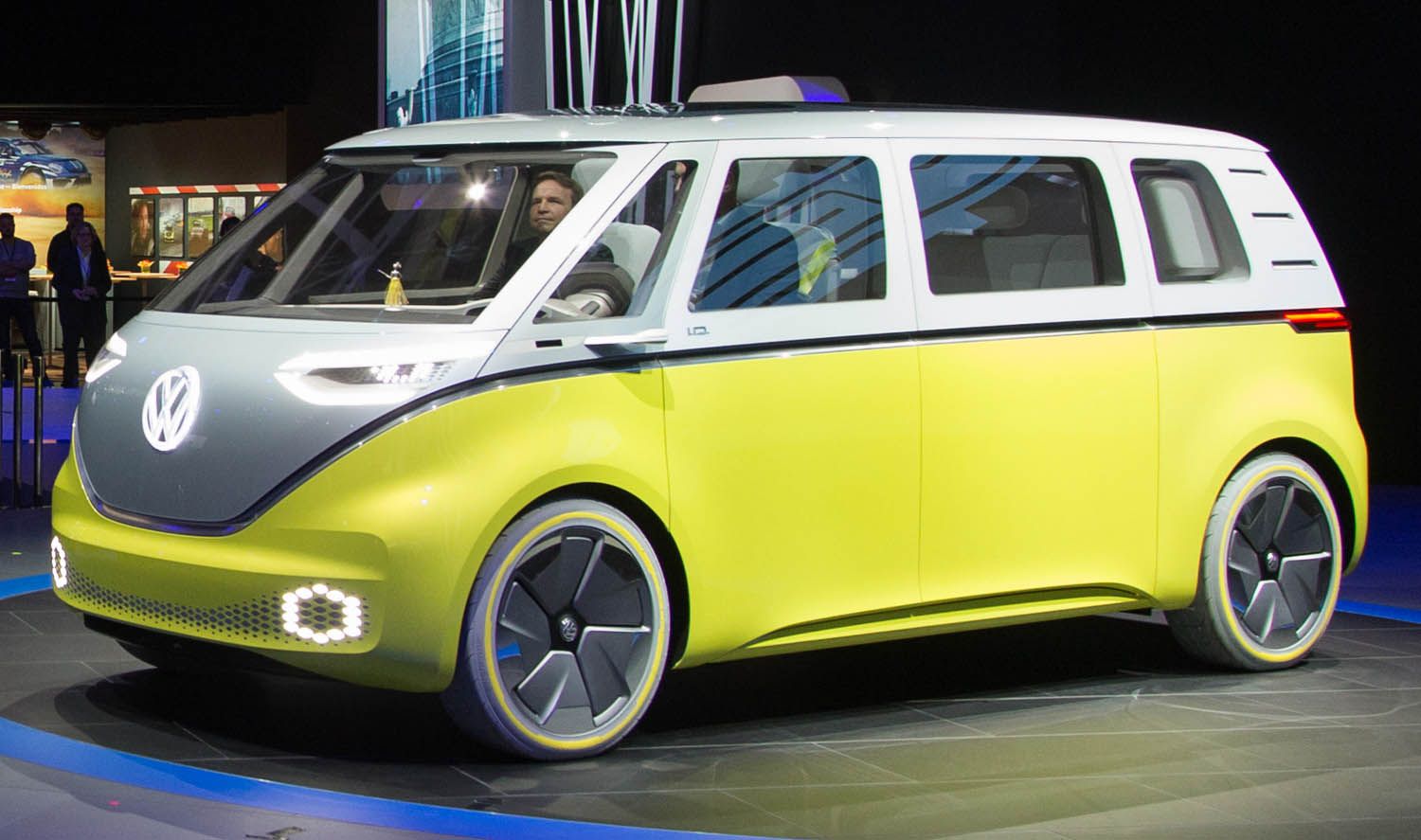
DRIVER ASSIST SYSTEMS
Many of the systems are included as standard. For example, Car2X (utilizing swarm data to enable warnings to be given of dangers in the immediate vicinity); Front Assist with pedestrian and cyclist monitoring (surrounding area monitoring system with emergency braking function); PreCrash occupant protection (including pre-tensioning the safety belts); and, in the case of the ID. Buzz Pro, Dynamic Road Sign Display and Lane Assist. Available as options are the two newest systems: Travel Assist with swarm data utilization and assisted lane changing, and Park Assist Plus with memory function for automated parking.
RUNNING GEAR
The basis for high levels of comfort and safety is the fundamental layout of the suspension. At the front, there is a strut-type setup, with a sophisticated multi-link arrangement at the back. Both axles are very compact, but the vehicles have wide tracks of 65.9 and 65.7 inches respectively. At the back, the wide track width provides ample room for feeding loads through between the wheelarches. In the case of the five seater, it is 47.4 in and 48.4 in for the cargo space in the van.
The ID. Buzz has available 18-, 19- 20- and 21-in wheels, but the Buzz Cargo is limited to 20-in rims. The front tires are always narrower than the rears, thus adding to the vehicle’s agility. The front brake discs go up to 15 inches in diameter, depending on wheel size, but both vehicles have wear-resistant drum brakes at the back.
The ID. Buzz can slow down without any friction braking. In the process the kinetic energy gets transformed into electric energy and fed into the battery. In automatic mode ‘D’ (Drive), the ID. Buzz sails along as soon as the driver lifts their foot off the drive pedal—the electric motor runs freely and offers no resistance. In this case the vehicle’s rolling increases the range. In automatic mode ‘B’ (Brake), the ID. Buzz slows down as soon as the driver eases off the drive pedal. The recuperation effect is now so great that the normal brakes are hardly used any more. This is particularly helpful on downhill stretches, as a great deal of energy gets recovered. A key role is played here by the electric brake servo: for braking up to around 0.3 g, the ID. Buzz brakes solely via the drive system.
EXTERIOR DESIGN
The design concept of the original ID. Buzz show car that debuted at Detroit in 2017 has been rigorously pursued for the full production version. That includes extremely short overhangs, maximum utilization of space on a minimal vehicle footprint, splitting the bodywork design into an upper and lower level, and the iconic V-shaped hood that mirrors the classic T1 Bus. Design followed function in the case of the T1, and that’s the same with the ID. Buzz. The iconic, clear form is accompanied here by outstanding aerodynamics: the ID. Buzz has a drag coefficient of 0.29. That helps to reduce electric power consumption and increase range.
TheID. Buzz makes full use of LEDs. At the front there are charismatic LED headlights with a slim lateral LED bar between them. The giant VW logo in the center of the bar is an homage to the classic T1 Bus. At the back, the ID. Buzz has horizontal LED taillights that are connected by an end-to-end light strip for the first time on a Volkswagen Commercial Vehicles model. The ID. Buzz is being offered with the ‘IQ.LIGHT – LED matrix headlights’ as an option.
Volkswagen Commercial Vehicles is offering the ID. Buzz and ID. Buzz Cargo—as is traditional for the Bus—both in the base colors and, as an alternative, in various two-tone finishes. The spectrum consists of a total of eleven color variants: one single-color paintwork finish (‘Candy White’); five metallic colors (‘Mono Silver’, ‘Lime Yellow’, ‘Starlight Blue’, ‘Energetic Orange’ and ‘Bay Leaf Green’); one pearl effect finish (‘Deep Black’); and four two-tone paintwork colors. Whenever the Bulli is ordered in one of the two-tone paintwork finishes, the upper section including roof and V-shaped hood will always be in ‘Candy White’. The areas below the character line running all around the vehicle are a choice of four metallic shades: ‘Lime Yellow’, ‘Starlight Blue’, ‘Energetic Orange’ or ‘Bay Leaf Green’.
AMPLE SPACE FOR LIFE ON THE MOVE
The driver and front-seat passenger sit on individual seats with inside adjustable armrests in the five-seater ID. Buzz. In the higher specification versions, the front seats have armrests on the outside, too. The top versions of the seats are completely electrically adjustable and have both a memory function and massage function. The front seats can be individually adjusted by up to 9.6 inches lengthways and 2.4 inches in . The triple bench rear seat can be split 60:40 and folded down. To create extra legroom or additional luggage space, it is also possible to move the rear bench seat lengthways by 5.9 in, either in its entirety or split 60:40. The MPV’s two sliding doors come as standard. As on option, they can be opened and closed electrically, just like the rear hatch. With five people on board, there is 39.6 cubic feet of luggage space behind the second row that expands to 77.9 cu ft when the second row is folded. The five-seater can take a payload of 1166 lb.
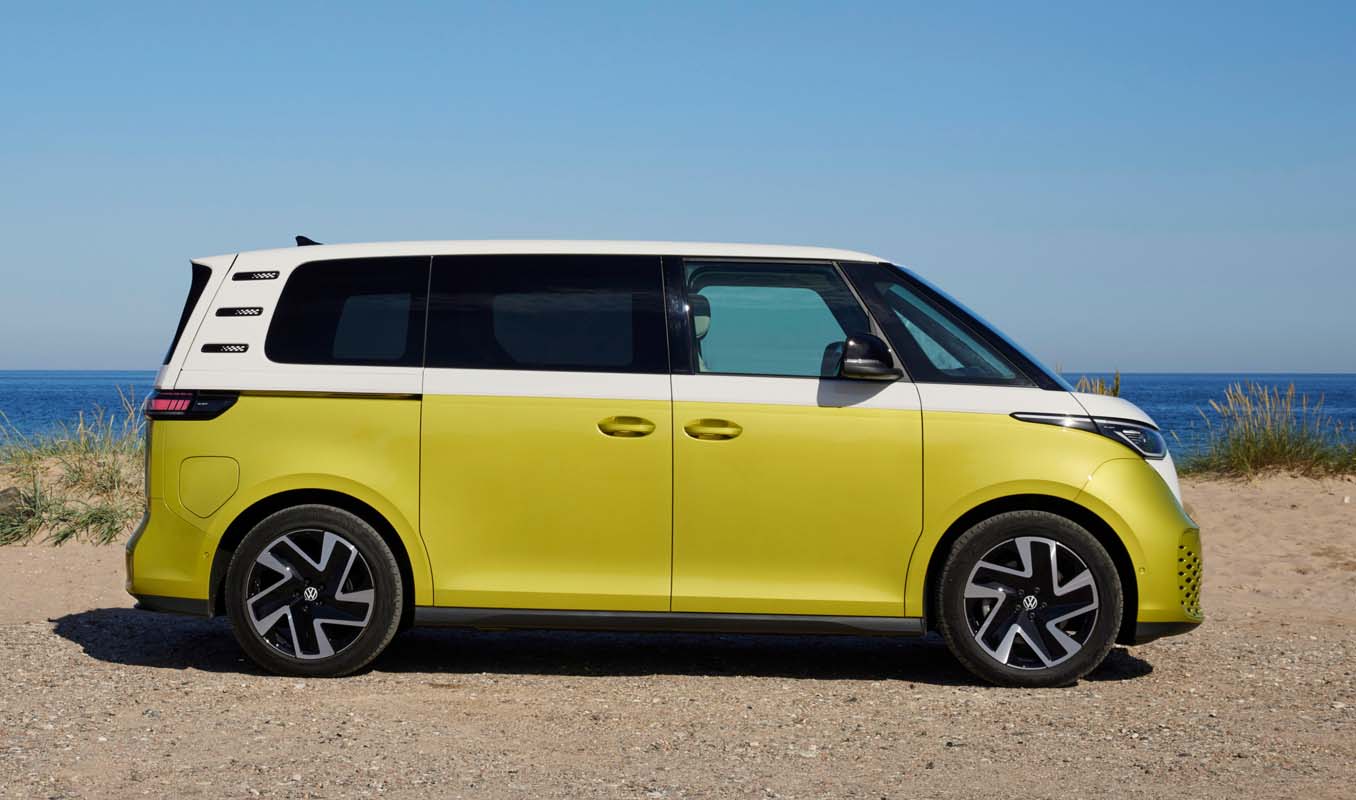
TheID. Buzz Cargo is being offered as standard with three seats in the cab: driver’s seat plus double bench seat. Alternatively, the ID. Buzz Cargo can also be ordered with an individual seat for the front-seat passenger. Behind the seats comes a fixed partition, separating off the cargo space. This partition is optionally available with a window and/or an opening through which items can be loaded. The cargo space capacity is 137.7 cu ft and provides room for two Euro pallets. The maximum payload of the ID. Buzz Cargo is 1429 lb. Loads can be secured via lashing rings in the floor and rails on the side walls. The ID. Buzz Cargo is fitted with a wide-opening rear hatch and a sliding door on the passenger side. The van is optionally available with an additional sliding door on the driver’s side and with rear double doors.
Getting into the new ID. Buzz means getting up into it. Typical of a Bus, it has a high, comfortable and commanding sitting position. Tailored to that, the instrument panel of the new MPV and van also have a very elevated position. The cockpit in front of the driver is formed by a free-standing 5.3 inch ID.Cockpit display. Positioned centrally in the middle of the dashboard is the ‘Ready 2 Discover’ infotainment system which has a standard 10-inch touchscreen. The optional ‘Discover Pro’ navigation system offers a 12-inch screen. Depending on the version, App-Connect (including App-Connect Wireless) for smart phone integration and DAB+ (digital radio) are included as standard.
The ID. Buzz is equipped with an Online Connectivity Unit (OCU), into which a fixed SIM card (eSIM) is integrated. Volkswagen Commercial Vehicles’ latest model utilizes the OCU to access the increasingly comprehensive range of online services and vehicle functions of We Connect and We Connect Plus. The We Connect functions are available free of charge and for an unlimited period. With no navigation system the range of We Connect Plus services are included free for a year; with the Discover Pro navigation system the We Connect Plus service is included as standard for three years.
The latest We Connect functions include ‘Plug & Charge’, ‘Temperature Guidance’ and ‘Battery Care Mode’. At compatible DC fast-charging stations, ‘Plug & Charge’ facilitates particularly easy charging. Where there is a forecast of cold weather and the battery is low on charge, the ‘Temperature Guidance’ service provides a reminder to charge it up. The ‘Battery Care Mode’ is a charging function that optimizes the service life of the high-voltage battery. If the driver has enabled Battery Care Mode, the upper charge level limit is set to 80 per cent. If necessary, for instance on long journeys, the Battery Care Mode can be manually disabled, and the battery charged up to 100 per cent. The ‘Online POI Search’, a navigation function of We Connect Plus, has been enhanced.
In the future, ID. Buzz owners will be able to individually purchase and download further apps and/or services via the infotainment system’s in-car shop. These new apps and services include Spotify and Apple Music, which can now be used in the ID. Buzz even without a paired smartphone. Simply load the app, register one time with the relevant access details, and you’re done!
The automatic transmission is operated via a steering column switch: turn it forwards from the neutral position ‘N’ to ‘D’ (Drive) and the vehicle moves off. One step further comes ‘B’ (Brake). In this case the electric drive system’s regenerative braking is so strong when moving forwards that the driver hardly has to touch the brake. One turn back from ‘N’ to ‘R’, and the ID. Buzz reverses.
The five-seater version is fitted with up to eight USB-C ports: to the right of the steering wheel are two USB-C ports and a tray for a smart phone with an inductive charging function. There is a further USB-C port in the front-passenger door and, dependent on specification, in the rear-view mirror mount. In the back of the ID. Buzz there are USB-C ports in the two sliding doors and on the left and right of the load space.
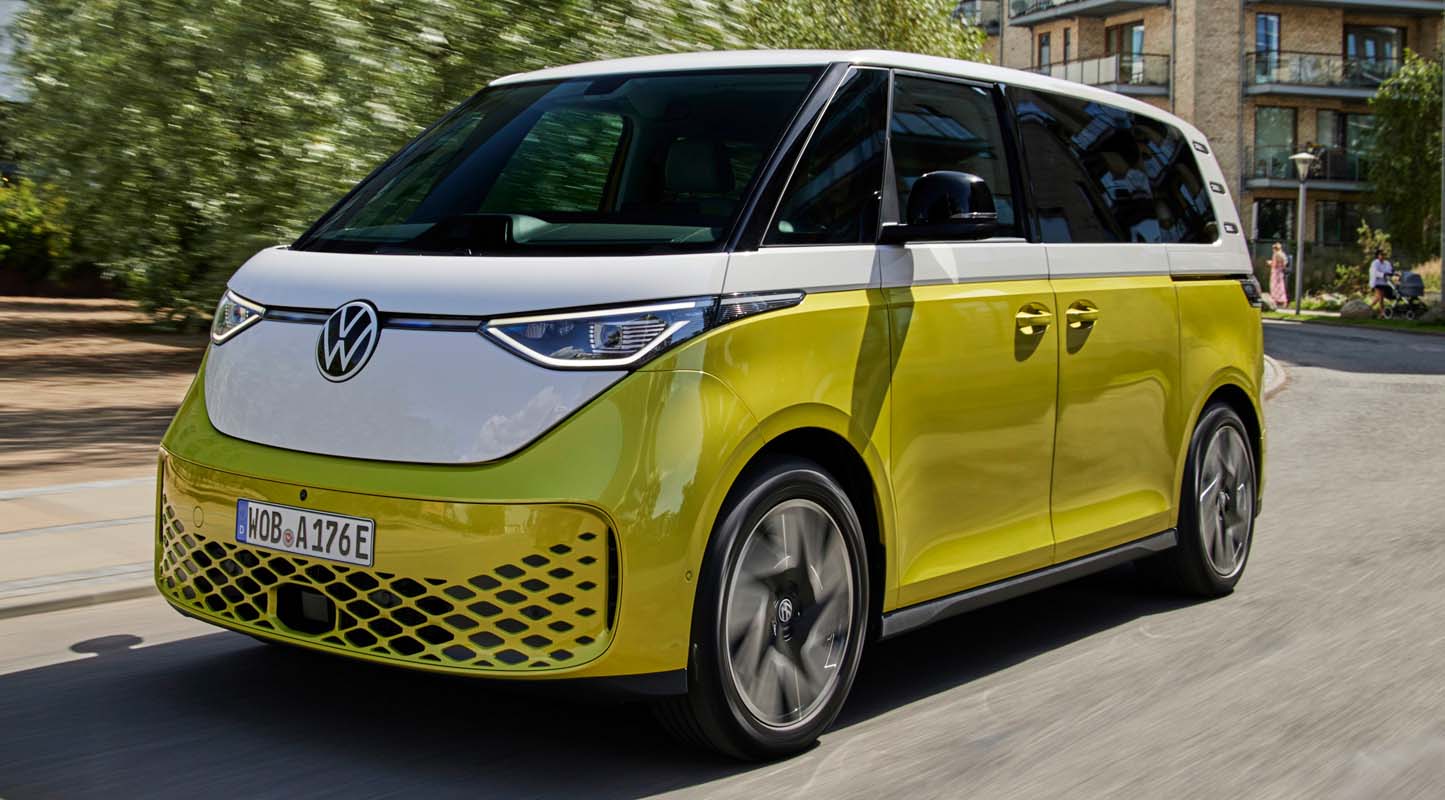
The ID. Buzz Cargo has up to five USB-C ports: one on the left on the instrument panel, two above the smart phone tray, one in the front-passenger door and another in combination with the rain sensor in the rear-view mirror mount. All USB-C ports (with the exception of the 15-watt one in the rear-view mirror mount) use the latest USB Power Delivery (USB-PD) charging standard that delivers up to 45 Watts. That enables, for example, laptops or rechargeable tools to be charged up three times as quickly as when plugged into conventional USB-C ports. Available as an option, housed within the frame of the front-passenger seat, is a 230-Volt socket for powering larger electrical appliances. Unlike vehicles with internal combustion engines, the 230-Volt connection in the electric ID. Buzz can also be used with the motor turned off.
As is the case for all models in Volkswagen’s electric vehicle family, the new five-seater ID. Buzz also comes with the interactive ‘ID. Light’. The narrow, illuminated strip stretches across in front of the windshield in the driver’s field of vision above the instrument panel. Via the ‘ID. Light’ the driver receives intuitively understandable information. This intuitive recognition and evaluation of the information is made especially easy by the position and color of the light signal. Two examples: a signal on the right of the light strip indicates, based on color, obstacles to the right front of the ID. Buzz. If ‘ID. Light’ glows completely in red, meanwhile, it is signaling: Beware! Brake!
As the ID. Buzz already has the ID. 3.2 Software on board, there are also four new/extended functions. The ‘Local Hazard Warning’ function informs the driver, thanks to Car2X, of any hazards up ahead, such as broken-down vehicles, accidents, or emergency vehicles. For example, a broken-down vehicle in the outside lane is visualized in the ‘ID. Light’. With Park Assist enabled, the new ‘Intelligent Parking Assistant’ function helps the driver to spot out a parking space identified by the system. The ‘Lane Change Recommendation’ function of ‘ID. Light’ provides the driver with early visual notice to change lane in the direction of the visualization as the next navigation maneuver.
The five-seater ID. Buzz is fitted as standard with 10-colour ambient lighting. As an option, Volkswagen Commercial Vehicles is also offering a 30-color version. The areas lit up by the individually selected shade are a light strip in the instrument panel, the decorative strips in the four doors, and the storage bins in the doors.
A new feature developed by Volkswagen Commercial Vehicles specifically for the ID. Buzz is the removable ID. Buzz Box. Its top part provides a large storage compartment. Integrated in there, always close at hand, are an ice scraper and a bottle opener. At the front there is a flip-open compartment with a capacity of 1.4 liters (e.g., for a water bottle), and at the back a 5-liter drawer for implements of every kind. Another example of the attention to detail in the new ID. Buzz is seen when the drawer is pulled out: embossed on its sides is a map of the world. The van’s ID. Buzz Box is specifically tailored to use at work. Its top section houses a large compartment for a laptop or clipboard, and a further cupholder. On the front it also has a 1.4-liter flip-open compartment. In the two-seater Cargo and five-seater MPV the box is latched in place between the driver’s seat and front passenger seat. It can be easily and quickly taken out and put back in.
SUSTAINABILITY—IN HARMONY WITH THE ENVIRONMENT
The ID. Buzz and ID. Buzz Cargo are supplied on a carbon-neutral basis: that is, the compensation of emissions arising from production in the German Hannover plant, the manufacture of all modules in Volkswagen Group Components factories, and the transportation up to the point of handover to customers all over Europe. Volkswagen Commercial Vehicles has set itself the objective in Europe of reducing the carbon footprint of all vehicles across their entire life cycle by 40 per cent by 2030 compared with 2018. The ID. Buzz plays a key role in this. In essence, the electric drive system of the ID. Buzz and ID. Buzz Cargo works CO2-free on the road. The carbon footprint is especially small if the battery is charged using renewable energy.
In addition, Volkswagen is utilizing a package of extremely innovative materials and processes that make both versions of the European ID. Buzz one of the world’s most sustainable model lines. The array of such measures starts with completely forgoing any use of leather in favour of using materials of non-animal origin. The steering wheel rim is, for example, made of a synthetic material that looks and feels as high quality as leather. The materials used for some seat covers, floor coverings and for the roof liner of the ID. Buzz include materials created from recycled products. There is, for example, a fabric made of so-called SEAQUAL® yarn, the fibers of which consist of about 10 per cent of collected ocean plastics and about 90 per cent of PES (recycled PET bottles). The ArtVelours ‘ECO’ seat covers also consist of 71 percent recycled materials.

